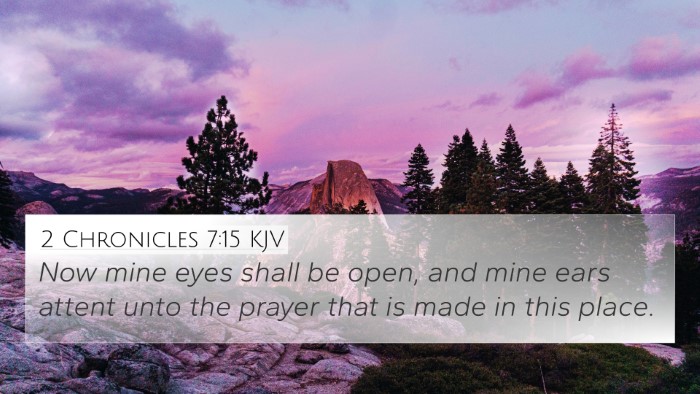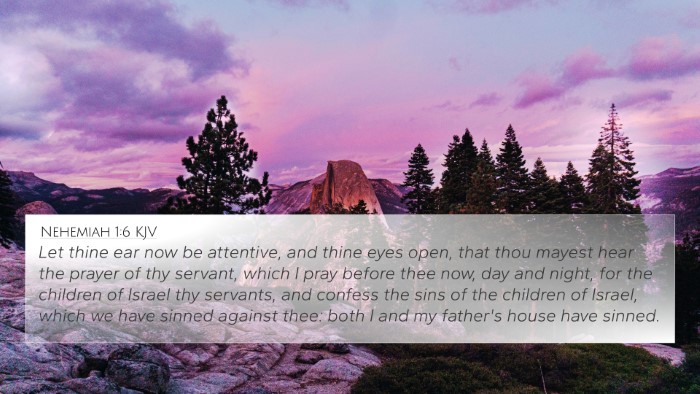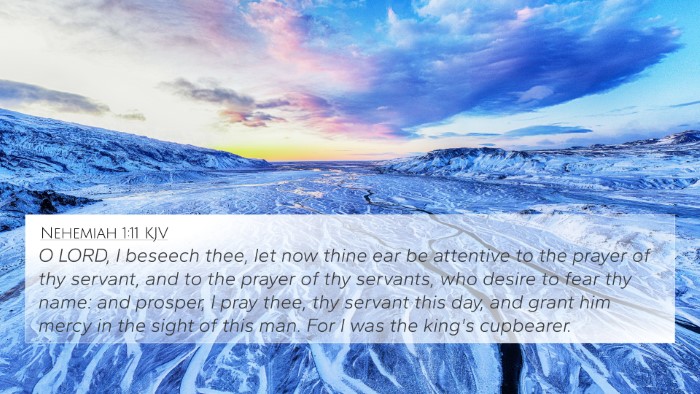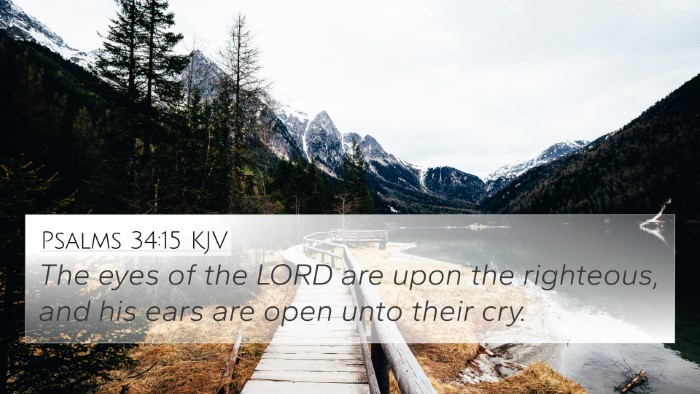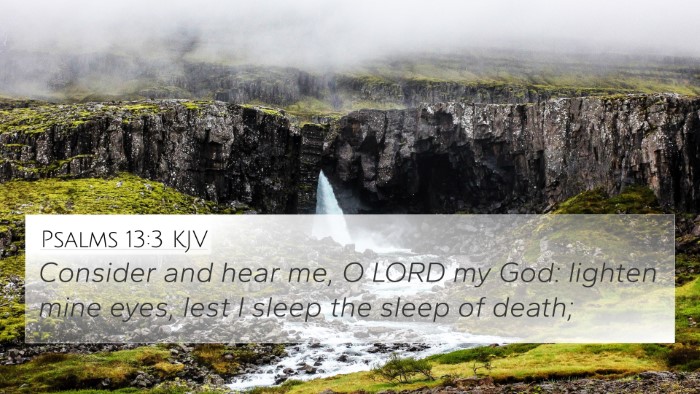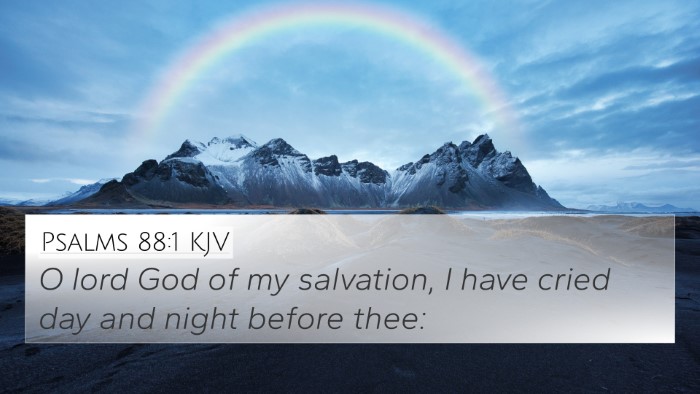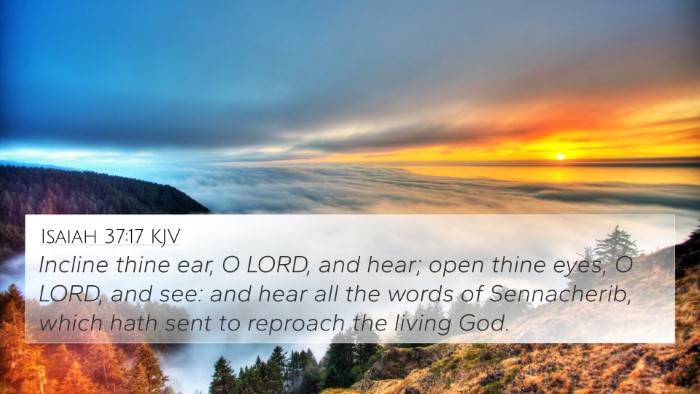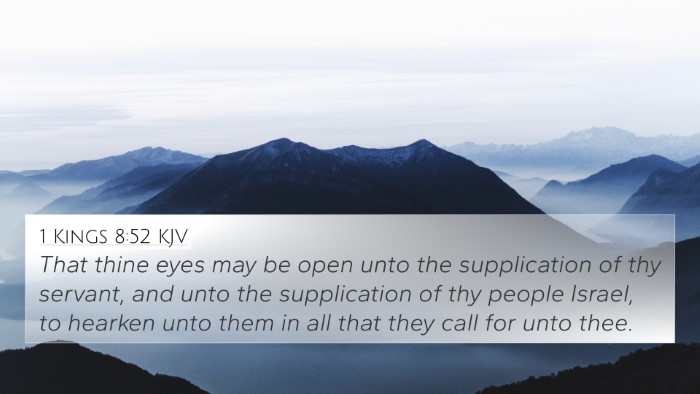Understanding 2 Chronicles 6:40
Bible Verse: 2 Chronicles 6:40
This verse reads:
"Now, my God, let Your eyes be open and Your ears attentive to the prayer that is made in this place."
Verse Meaning and Interpretation
The verse serves as a part of Solomon's dedicatory prayer for the temple, emphasizing the significance of prayer and the presence of God in this holy place. Here we can amalgamate insights from various public domain commentaries, such as those by Matthew Henry, Adam Clarke, and Albert Barnes, to derive a comprehensive understanding of this verse.
Key Themes
- The Importance of Prayer: This verse highlights the essential nature of prayer in a relationship with God. Solomon acknowledges that God’s attention is drawn to the prayers offered in the temple, indicating the temple as a special place of communication with the Divine.
- Divine Presence: The request for God’s eyes to be open and ears attentive symbolizes a longing for God's active participation in the lives of His people. Solomon expresses an understanding that the temple is not just a building but a significant location for divine encounters.
- God's Faithfulness: By praying for God's attention to be present in this place, Solomon also reflects the faithfulness of God in response to the prayers of His people. It signifies trust in God's willingness to engage with those who seek Him.
- The Role of the Temple: The temple is positioned at the heart of Israel's worship and relationship with God. It represents a pivotal location for worship, sacrifice, and supplication, which Solomon explicitly acknowledges in this prayer.
Commentary Insights
Matthew Henry: Henry notes that the supplications offered in the temple should be pure and sincere. He emphasizes the necessity for believers to come to God earnestly, with the certainty that He hears their prayers.
Albert Barnes: Barnes highlights the assurance that God’s ear is ever attentive to those who pray sincerely. He elucidates the relationship between God’s omniscience and the act of prayer in a set apart place, such as the temple, which affirms the sacredness of worship.
Adam Clarke: Clarke stresses that this prayer represents Solomon's desire that the temple be recognized as a spot where God would be approachable. He points out that the emphasis lies on God's engagement with people rather than solely the structure of the building.
Bible Verse Cross-References
To deepen our understanding of 2 Chronicles 6:40, we can look at the following cross-referenced verses:
- 1 Kings 8:29: “That Your eyes may be open toward this temple night and day...” - underscoring God's watchfulness over the temple.
- Psalms 84:1-2: “How lovely is Your dwelling place, O God of hosts!” - a reflection on the sacredness of worship environments.
- Psalms 145:18: “The LORD is near to all who call on him...” - affirming God’s availability to those who seek Him.
- Isaiah 56:7: “My house shall be called a house of prayer...” - reinforcing the temple's role as a place of prayer.
- Hebrews 10:19-22: “Having boldness to enter the Holiest...” - connecting the concept of drawing near to God through Christ.
- James 5:16: “The prayer of a righteous person is powerful and effective.” - illustrating the power of prayer.
- 1 Peter 3:12: “For the eyes of the Lord are on the righteous...” - emphasizing God’s care for His people and their prayers.
Connections Beyond the Verse
Understanding this verse involves looking at the broader context of prayer and God's presence throughout the Scriptures. The thematic Bible verse connections give us additional depth:
- The connection between the Old Testament temple worship and the New Testament concept of believers as temples of the Holy Spirit (1 Corinthians 6:19).
- The linkage of Solomon's prayer to Jesus' teachings on prayer in the Gospels (Matthew 6).
- Exploration of how prayers exhibited in the Old Testament echo in the apostolic prayers seen in the epistles, highlighting the unbroken dialogue with God.
How to Use Bible Cross-References
For those seeking to delve deeper into this verse, utilizing tools for Bible cross-referencing becomes essential. Here are practical suggestions:
- Utilize a Bible concordance to locate related terms and themes.
- Engage in cross-reference Bible study by checking notes in your Bible’s marginal references.
- Employ a comprehensive Bible cross-reference guide to find thematic connections.
- Explore resources that highlight Bible chain references for a systematic approach to study.
Conclusion
This analysis of 2 Chronicles 6:40 elucidates not only the immediate significance of Solomon’s words but also the broader implications of prayer in our worship practices. Encouraging believers to actively engage with Scripture through tools that facilitate cross-referencing Biblical texts allows for a deeper appreciation of the text's inter-Biblical dialogue and its relevance for contemporary faith practice.



